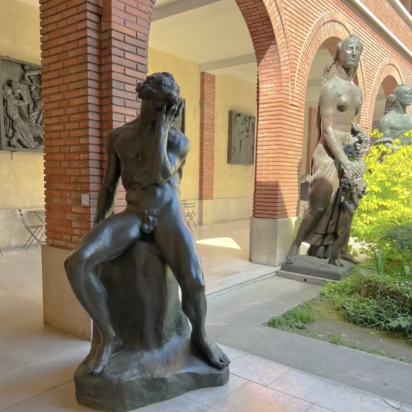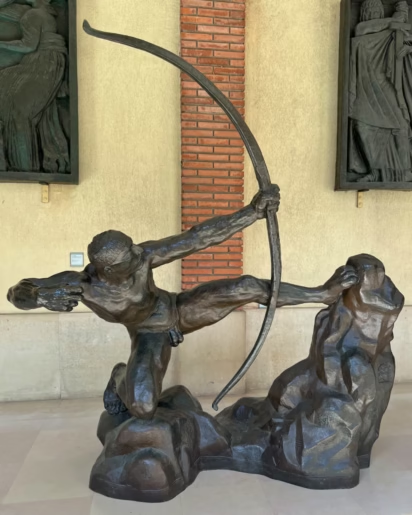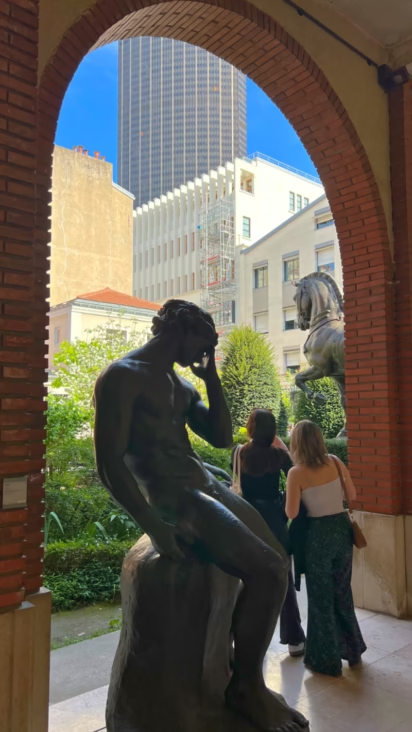Visit the free Musée Bourdelle to see sculptures by Antoine Bourdelle (1861-1929) in a museum in his original studios and leafy garden in Montparnasse in Paris.

French sculptor Antoine Bourdelle (1861-1929) played a major role in the development of modern and monumental sculptures. The Musée Bourdelle, a short block from the Tour Montparnasse in Paris, is dedicated to his work and life. The museum uses the original studios and workshops to exhibit many of Bourdelle’s famous large sculptures, original plaster models, and a wealth of his studies, designs, and art. Admission is free.
Visit Bourdelle Museum of Sculptures in Paris
The Musée Bourdelle is inside the original studios, workshop, and ateliers of French sculptor Antoine Bourdelle (1861-1929). Bourdelle lived and worked here in Montparnasse for over four decades. He moved in at age 23 and managed to vastly expand his property as his fame grew.
Antoine Bourdelle was a highly regarded sculptor during his lifetime and is particularly well-known for his monumental designs. He was a student of Auguste Rodin and a teacher for many artists including Henri Matisse and Alberto Giacometti. He played a major role in the development of modern sculpture and the Art Deco.
The Musée Bourdelle is spread through several studios, a garden, a courtyard, patios, and a modern wing. The original museum concept was to show Bourdelle at work with his studios almost untouched since his death while further large works (some acquired only much later) are displayed in the gardens and purpose-built museum building.
Street-Side Garden

Entry into the museum is through a modern ticket office which leads to the porticos and the crowded street-side garden (Jardin sur rue).
Visitors are welcomed by one of Bourdelle’s first large sculptures: a manspreading nude Adam (1889) shown post-sin, his head in hand. The four monumental allegories represent Liberty / La Liberté, Strength / La Force, Victory / La Victoire et Eloquence / L’Éloquence — they were made for the base of the Monument to General Alvear, an equestrian statue in Buenos Aires.
The most dominant sculpture in the garden is a large bronze horse from one of the studies for the Monument to General Alvear — further copies and versions are displayed elsewhere in the museum. Also, note in the garden the female Le Fruit and a bust of his teacher Auguste Rodin.
Unfortunately, the plaster casts hall with the originals of Bourdelle’s largest works has been inaccessible for some time.
Bourdelle’s Hercules the Archer
A copy of Antoine Bourdelle’s most famous work, Hercules the Archer / Héraklés archer (1906-9), is in the portico. A heroic nude Hercules spans his bow, legs spread and feet firmly planted, in preparation to kill the birds of Lake Stymphalia.
Rodin used a Belgian soldier as a model for his famous The Age of Bronze and for similar reasons — requiring a muscular athletic body — Bourdelle had a French commandant, Paul Doyen-Parigot, model for his Hercules.
The original full-size Hercules the Archer measuring around 250 cm by 240 cm (98″ x 94″) was made on commission for Gabriel Thomas, a cousin of the Impressionist painter Berthe Morisot. The gilt-bronze sculpture was very well received and Thomas later allowed Bourdelle to have more cast. A second version produced after 1923 has symbols of the hydra and Nemean lion on the rock.
The original bronze-gilt Hercules is now in the Waldemarsudde in Stockholm. In Paris, a gilt 1923 version is in the Musée d’Orsay, while a further bronze is inside Montparnasse station (hall 2).
Inside the museum are several smaller working models showing how Bourdelle developed the sculpture before settling for the full-scale model. Photos of the nude soldier show him from behind, which is quite appropriate — at Doyen-Parigot’s request, Bourdelle used a completely different face to preserve his modesty. (The original 1909 plaster model is in the Musée Ingres Bourdelle in Montauban.)
Ateliers at the Bourdelle Museum

Bourdelle moved into a small studio in 1884 but gradually acquired adjacent properties as his fame and wealth increased so the complex was never a purpose-built or fully integrated unit. The museum preserved several ateliers in their original condition.
In the painting studio are paintings and other artworks owned by Bourdelle. He also painted but was a particularly nifty pastelist, which was fortunate as those were handy earners.
His sculpture studio is basically as he left it. It has uncompleted works, smaller sculptures, things he collected, and even the curtained mezzanine where he used to sleep as a young artist. The Dying Centaur was close to his heart — he often compared himself to a centaur and his family used this sculpture after his death in memorial sessions. In the adjacent room, video screens explain several sculpting techniques and how bronzes are cast.
Exhibition Rooms


In the modern exhibition rooms are many further sculptures, studies, and items Bourdelle used. Highlights here include:
- The Warrior from the war monument Memorial to the Warriors and Defenders of Tarn-et-Garonne in the Franco-Prussian War (1870-71) that Bourdelle designed for the city of Montauban. The monument was controversial and certain elements were rejected.
- Three Howling Heads / Têtes hurlantes — designed for the same war monument (but not used) as allegories of war: Suffering and Death are silent but Terror howls incessantly.
- Head of Apollo / Fighting Apollo — often considered the work that showed Bourdelle’s departure from the artistic influence of Rodin. Bourdelle started this head in 1898 but only returned to it a decade later. Like Rodin’s Walking Man, Bourdelle did not cover up the cracks but rather enhanced them with golden gilding to emphasize the dichotomy in Apollo’s nature.
- Busts of Beethoven — Bourdelle loved his music and made over 40 versions of the German composer.
Temporary exhibitions are staged on the lower level while the upper level is only open on reservation for art students.
Inner Garden and Promenade


Several further large bronzes are in the inner garden (Jardin intérieur) and a long, narrow promenade:
Hannibal’s First Victory / Première Victoire d’Hannibal — an early work (1885) showing a nude boy with a large eagle. It illustrated an act of cruelty famous from the Gustav Faubert novel Salammbô. As a boy, the later Carthaginian General brutally killed an eagle.
France — a large sculpture of Athena (1923-25) intended for a (never erected) memorial to commemorate the United States entering the First World War on the side of France in 1917.


Virgin with Offering (1919-22) — Bourdelle used his wife and daughter as models and the iconography of the Madonna and Child in a memorial commissioned by Joseph Vogt after his Alsatian village Niederbruck was spared destruction during the First World War.
Dying Centaur — a large bronze of a man with the body of a horse.
A large copy of the equestrian Monument of General Alvear is at the far end of the promenade, while a smaller bronze (1987) of the third version (1915) is seen earlier. The Republic of Argentina ordered this sculpture — Bourdelle’s most famous international commission. He worked on it for a decade before the final version in 1923 was accepted. The final bronze was cast in 1926 and is now standing in Buenos Aires on a 14-m high plinth surrounded by the four allegories (of which copies are in the museum’s front garden).
Visitor Information: Bourdelle Museum in Paris
The Musée Bourdelle is open Tuesday to Sunday from 10:00 to 18:00.
Admission to the permanent collection of the Bourdelle Museum is free and time-slot reservations are not currently necessary (or possible). Admission may be charged for some temporary exhibitions.
A pleasant small cafe is on the upper level with wonderful views of the garden.
Descriptions in the museum are only in French but a very handy audioguide is available as a free app — download (and load the tours) before visiting the museum, or use the free wifi onsite.
The Musée Boudelle, 18 rue Antoine Bourdelle, 75015 Paris, is a block from the massive Montparnasse station complex and the Tour Montparnasse. The easiest metro access is from Montparnasse-Bienvenüe station exit 2 (lines 4, 6, 12, 13). Falguière station (metro 12 only) avoids the crowds of Montparnasse station.
It is easy to combine seeing the Bourdelle Museum with visiting the working studios of contemporary artists nearby. At the T-junction of Antoine-Bourdelle with Avenue du Maine, at 21, is Chemin du Montparnasse, which is lined with ateliers. Entry into this impasse is free but artists here set their own individual hours — more likely in the afternoons than mornings and rarely on Mondays.
→ See also Claude Monet Paintings in Museums in Paris for the world’s best collections of top artworks by Monet and other Impressionist artists and the Musée Rodin for more sculptures by Auguste Rodin.


